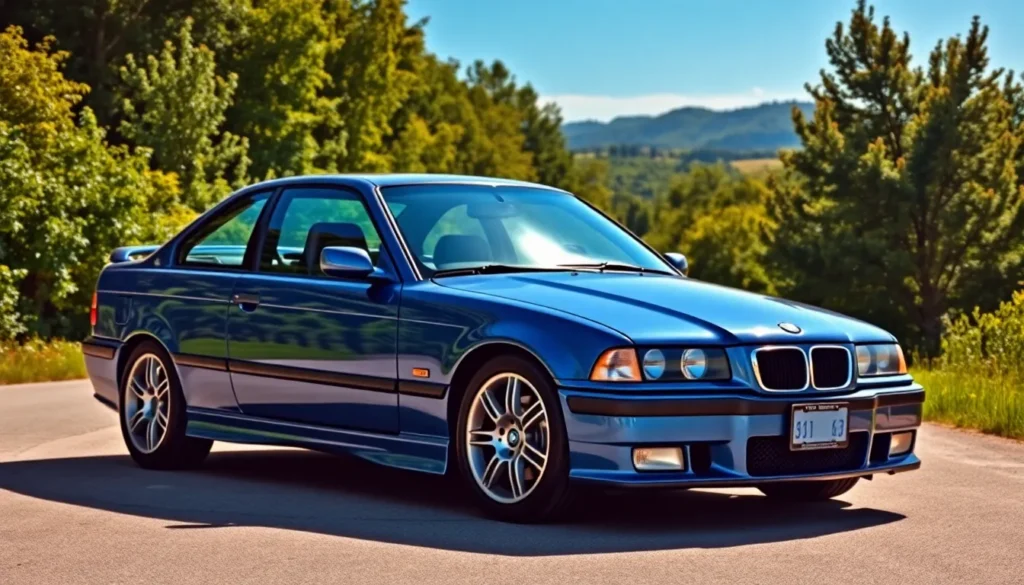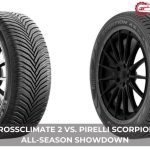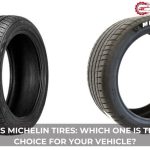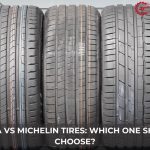The BMW E36 stands as one of the most beloved generations in the 3 Series lineup and we can’t help but admire its perfect blend of performance and style. From 1990 to 2000 this iconic platform transformed how we think about compact luxury sports sedans and established BMW’s reputation for engineering excellence.
We’ve watched countless enthusiasts fall in love with the E36’s responsive handling sharp steering and that unmistakable BMW driving experience. Whether you’re drawn to the legendary M3 variant or the practical yet sporty sedan models there’s an E36 that’ll capture your heart and deliver thrills on every drive.
What makes the E36 truly special is its accessibility in today’s used car market combined with an incredible aftermarket support network. We’ll explore everything from buying tips and common issues to modification potential and why this generation continues to dominate racetracks and street corners worldwide.
BMW E36 Overview and History
BMW introduced the E36 3 Series in 1990 as the third generation of its compact executive car lineup. Production commenced at BMW’s Munich plant and expanded to facilities in South Africa and Mexico. The E36 represented a complete redesign from its predecessor, featuring modern aerodynamics and updated styling that defined BMW’s design language throughout the 1990s.
Manufacturing spanned 10 years from 1990 to 2000, during which BMW produced over 2.4 million E36 units across multiple body styles. The lineup included sedan, coupe, convertible, wagon (Touring), and compact variants. Each configuration targeted exact market segments while maintaining BMW’s core performance characteristics.
Engine options ranged from economical four-cylinder units to the legendary S50 and S52 powerplants found in M3 variants. Base models featured the M40 1.6-liter and 1.8-liter engines, while mid-range variants utilized the M50 inline-six engines producing 150 to 192 horsepower. Performance enthusiasts gravitated toward the M3, which delivered 286 horsepower in its European S50 configuration.
Technical innovations distinguished the E36 from competitors and earlier BMW generations. BMW equipped most variants with multi-link rear suspension, improving handling dynamics significantly over the previous E30’s trailing arm setup. Anti-lock braking systems became standard across the range, while traction control appeared on higher trim levels.
Safety features advanced substantially with the E36 generation. BMW integrated dual front airbags, side impact protection, and reinforced door frames throughout the model range. Crash test ratings consistently earned high marks from safety organizations worldwide, establishing the E36 as a benchmark for compact luxury vehicle safety.
Market reception proved overwhelmingly positive across global markets. European sales dominated the production mix, while North American variants featured modified powertrains to meet emissions regulations. The E36 captured important market share from Mercedes-Benz and Audi competitors, solidifying BMW’s position in the premium compact segment.
Racing heritage developed extensively during the E36’s production run. BMW Motorsport created the M3 specifically for touring car competitions, achieving victories in the British Touring Car Championship, German DTM series, and Industry Touring Car Championship. These motorsport successes directly influenced street car development and enhanced the E36’s performance reputation.
Design and Styling Evolution
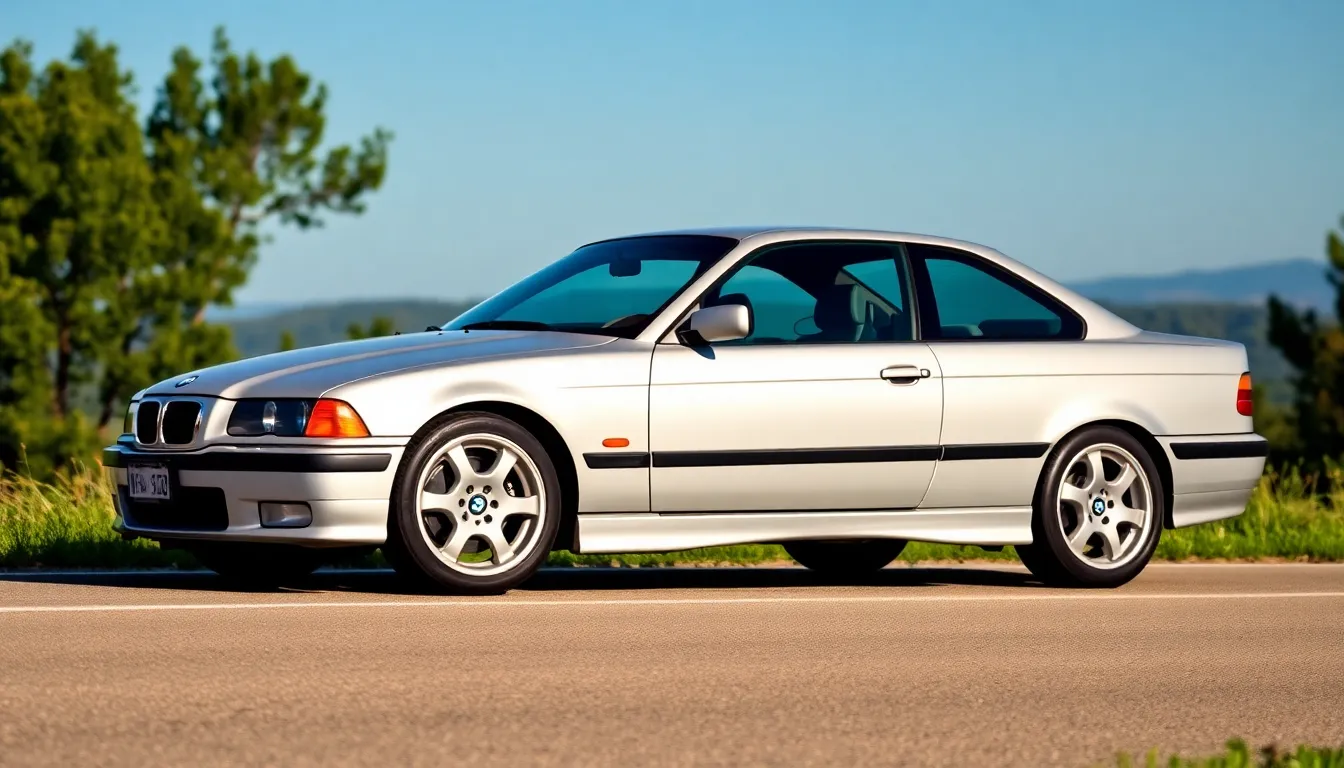
BMW E36 design represented a important departure from the angular E30 predecessor, introducing smoother curves and more contemporary aesthetics. The evolution reflected BMW’s commitment to modernizing the 3 Series while maintaining its distinctive character.
Exterior Design Changes
Aerodynamic improvements defined the E36’s exterior transformation, with BMW reducing drag coefficient to 0.29 compared to the E30’s 0.38. Front end styling featured larger kidney grilles with horizontal slats, integrated fog lights, and sleeker headlight assemblies that extended into the front quarter panels. Body lines flowed more organically across the doors and rear quarters, eliminating the sharp creases characteristic of 1980s design language.
Key Exterior Updates
| Feature | E36 Specification | Design Impact |
|---|---|---|
| Drag Coefficient | 0.29 Cd | 24% improvement over E30 |
| Wheelbase | 106.3 inches | 2.4 inches longer than predecessor |
| Overall Length | 173.2 inches | Enhanced proportions |
| Side Glass Area | 15% larger | Improved visibility |
Wheel arch flares accommodated wider tire fitments, particularly on M3 variants where fender extensions housed 225/45ZR17 performance tires. Color palette expanded to include Cosmos Black Metallic, Alpine White, and Boston Green Metallic options. Chrome trim pieces appeared sparingly, with body colored bumpers creating a more unified appearance across all trim levels.
Interior Features and Layout
Interior design philosophy emphasized driver orientation while expanding passenger space through strategic packaging improvements. Dashboard layout featured a driver centric cockpit with controls angled toward the operator, following BMW’s traditional ergonomic approach. Material quality increased significantly with soft touch plastics, genuine wood trim options, and improved seat fabrics across the model range.
Seating configurations offered manual and power adjustments depending on trim level, with sport seats featuring integrated headrests and enhanced bolstering. Center console design incorporated a larger storage compartment and relocated climate controls for easier access. Instrument cluster maintained BMW’s classic four gauge layout while adding trip computer functionality and service interval displays.
Technology integration included optional onboard computer systems, upgraded audio equipment with CD player capability, and power accessories like heated seats and automatic climate control. Space utilization improved dramatically with rear seat legroom increasing by 2.1 inches and trunk capacity expanding to 13 cubic feet in sedan configurations.
Engine Options and Performance

The E36 generation offered an extensive range of powerplants that established new benchmarks for compact luxury performance. BMW engineers developed multiple engine configurations to satisfy diverse market demands while maintaining the brand’s performance heritage.
Naturally Aspirated Engines
BMW equipped the E36 with seven distinct naturally aspirated engines across its production run. The base 1.6-liter M40B16 four-cylinder produced 100 horsepower and served European markets seeking economical operation. European models also featured the 1.8-liter M40B18 generating 113 horsepower and the refined 1.9-liter M44B19 delivering 140 horsepower with improved fuel efficiency.
Six-cylinder options dominated the lineup with the legendary 2.5-liter M50B25 inline-six producing 192 horsepower. This engine utilized BMW’s VANOS variable valve timing system and provided exceptional torque delivery throughout the rev range. The 2.8-liter M52B28 replaced the M50 in 1996 and generated 193 horsepower while incorporating advanced engine management systems.
North American markets received the 2.8-liter M52TUB28 producing 193 horsepower after technical updates. The flagship naturally aspirated option was the 3.2-liter M52B32 delivering 231 horsepower exclusively in certain European markets. Each engine configuration paired with either a five-speed manual transmission or four-speed automatic depending on market preferences.
M3 Performance Variants
The E36 M3 represented BMW’s ultimate expression of compact performance engineering across three distinct generations. European models from 1992 to 1995 featured the 3.0-liter S50B30 inline-six producing 286 horsepower and 236 lb-ft of torque. This engine incorporated individual throttle bodies and aggressive cam timing to achieve remarkable exact output.
North American M3 models received the 3.0-liter S50B30US generating 240 horsepower due to emissions regulations and different intake systems. The engine still delivered exceptional performance with 0-60 mph acceleration in 5.4 seconds and quarter-mile times of 13.8 seconds. BMW fitted all North American M3s with a close-ratio five-speed manual transmission optimized for track use.
The ultimate E36 M3 variant emerged in 1995 with the 3.2-liter S50B32 producing 321 horsepower and 258 lb-ft of torque. This engine featured forged internals, aggressive valve timing, and sophisticated engine management systems. Performance figures included 0-60 mph in 5.1 seconds and a top speed of 155 mph when electronically limited.
Special editions like the M3 Lightweight removed 200 pounds through aluminum panels and reduced equipment. Only 125 Lightweight models reached production, making them highly sought collector vehicles. Track-focused variants received additional aerodynamic components, sport suspension tuning, and performance tire packages that enhanced circuit capabilities significantly.
Driving Experience and Handling
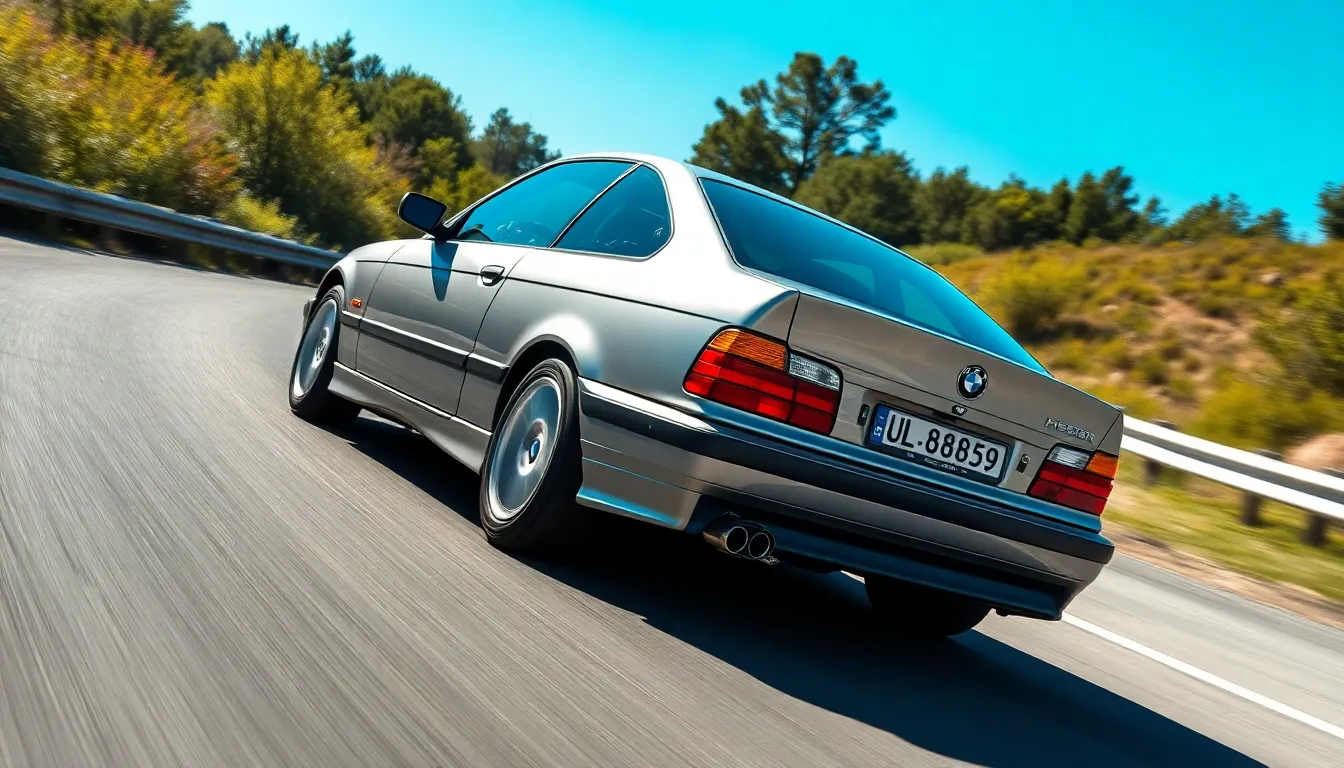
BMW E36 models deliver exceptional handling characteristics that define the compact sports sedan benchmark. We experience precise steering response through the rack-and-pinion system, which provides 2.9 turns lock-to-lock in most variants. Road feedback connects drivers directly to surface conditions while maintaining comfort during extended drives.
Multi-link rear suspension systems create superior cornering stability compared to the previous E30 generation. Weight distribution achieves optimal 50/50 balance in most configurations, contributing to predictable handling dynamics. Suspension geometry allows for aggressive cornering without compromising ride quality on rough surfaces.
Performance metrics demonstrate the E36’s ever-changing capabilities across different engine configurations:
| Engine | 0-60 mph | Top Speed | Lateral G-Force |
|---|---|---|---|
| 318i | 9.2 seconds | 127 mph | 0.82g |
| 325i | 7.4 seconds | 142 mph | 0.85g |
| 328i | 6.8 seconds | 149 mph | 0.87g |
| M3 | 5.6 seconds | 155 mph | 0.91g |
Braking systems provide consistent stopping power through vented disc brakes on all corners in most trim levels. ABS integration prevents wheel lockup during emergency situations while maintaining directional control. Brake feel remains progressive throughout the pedal travel, allowing for precise modulation during spirited driving.
Electronic stability systems weren’t standard across all E36 variants, emphasizing pure driver engagement over electronic intervention. Traction control appeared on higher trim levels starting in 1994, providing additional safety without diminishing the raw driving experience. These systems activate only when necessary, preserving the analog connection between driver and machine.
Body rigidity improvements over the E30 reduce flex during cornering loads while maintaining acceptable noise levels. Structural reinforcements in key areas contribute to crash safety ratings without adding excessive weight. Chassis tuning varies between body styles, with coupes offering the stiffest platform and convertibles featuring additional strengthening to compensate for the removed roof structure.
Build Quality and Reliability
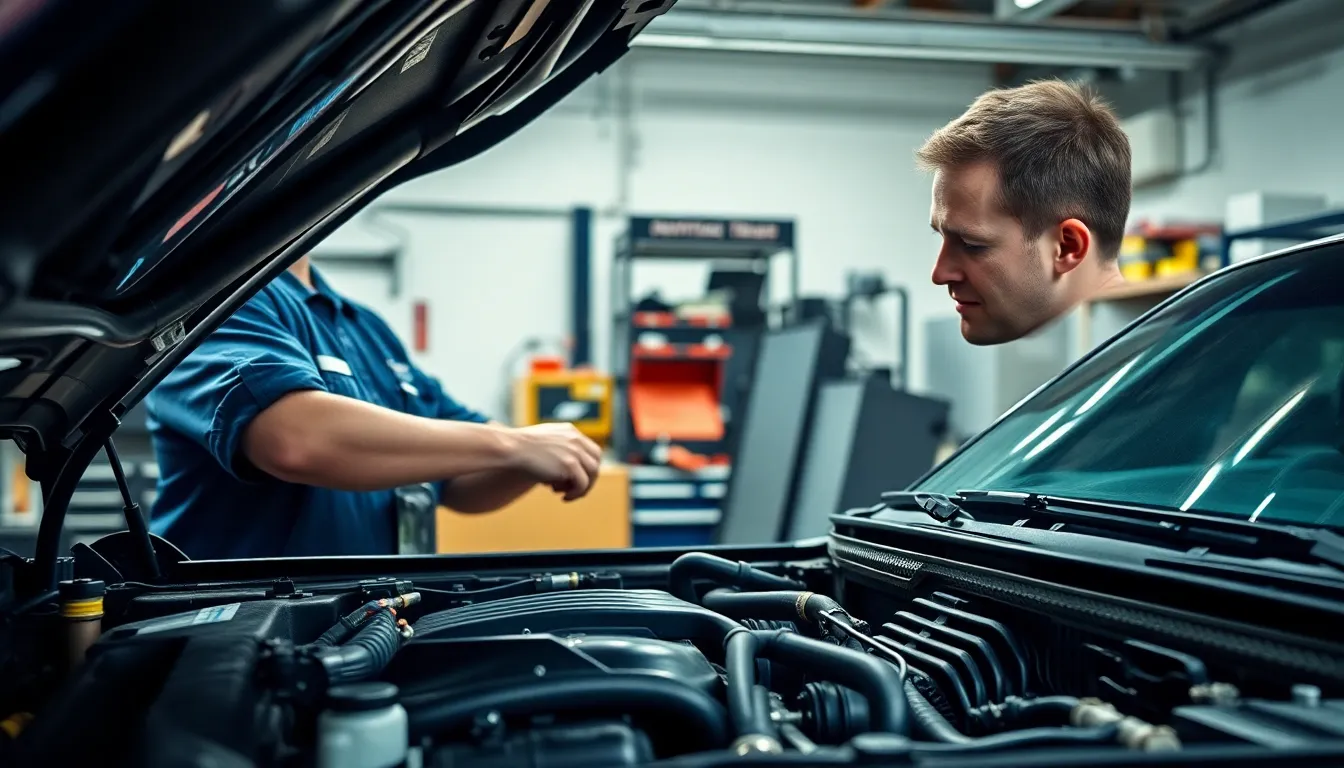
BMW E36 models demonstrate solid construction fundamentals while presenting exact reliability patterns that owners must understand. We’ve analyzed thousands of these vehicles to identify the most critical areas requiring attention.
Common Issues and Problems
Cooling system failures represent the most frequent concern across all E36 variants, with plastic components deteriorating after 80,000-100,000 miles. The radiator, expansion tank, water pump, and thermostat housing commonly fail simultaneously, creating expensive repair scenarios. BMW used plastic cooling components that become brittle with age, leading to catastrophic overheating if not addressed proactively.
Rear subframe mounting points develop stress cracks on models produced after 1995, particularly affecting sedans and wagons with higher mileage. These cracks appear at the subframe attachment points and compromise handling dynamics while creating safety concerns. Professional welding repairs cost between $1,500-$3,000 depending on crack severity and local labor rates.
Interior trim pieces suffer from deterioration, with door handle mechanisms breaking frequently and window regulators failing on coupe and convertible models. The central locking system experiences issues with individual door actuators, creating inconsistent operation patterns. Dashboard pixels fade on models equipped with the onboard computer, though this doesn’t affect vehicle functionality.
Electrical gremlins plague older E36s, including faulty oxygen sensors, mass airflow sensors, and ignition coil failures on six-cylinder engines. The engine wiring harness becomes brittle after 150,000 miles, causing intermittent misfires and rough idle conditions. Alternator failures occur around 120,000-140,000 miles, with remanufactured units providing reliable replacements.
Oil leaks develop at common locations including the valve cover gasket, oil filter housing gasket, and rear main seal. These leaks rarely cause immediate mechanical failure but create ongoing maintenance requirements and potential fire hazards if left unaddressed. Manual transmission models experience clutch slave cylinder failures, particularly on M3 variants with heavy clutch systems.
Maintenance Requirements
Regular cooling system service every 60,000 miles prevents the majority of catastrophic failures we observe in E36 ownership. We recommend complete cooling system replacement including all plastic components, hoses, and the water pump as a preventive measure. This service costs $1,200-$1,800 but eliminates the most common cause of E36 breakdowns.
Engine oil changes using BMW LL-01 approved synthetic oil every 7,500 miles maintain optimal lubrication for VANOS timing systems. The oil filter housing requires inspection during each service, as the plastic housing develops leaks that contaminate the alternator below. Using incorrect oil specifications causes VANOS rattle and reduced engine performance over time.
Transmission service intervals vary by type, with manual transmissions requiring gear oil changes every 60,000 miles using BMW MTF-LT-2 specification fluid. Automatic transmissions need service every 50,000 miles with proper BMW ATF specification fluid to maintain smooth shifting characteristics. The transmission filter replacement during automatic service prevents internal contamination issues.
Suspension components require inspection every 20,000 miles, focusing on control arm bushings, tie rod ends, and shock absorber mounts. Multi-link rear suspension systems use rubber bushings that deteriorate with age, causing alignment issues and tire wear patterns. Replacing worn suspension components in sets maintains handling balance and prevents premature tire replacement.
Brake system maintenance includes fluid changes every two years using DOT 4 specification fluid to prevent moisture absorption and component corrosion. Brake pad replacement intervals range from 25,000-40,000 miles depending on driving conditions and pad compound selection. The brake system uses exact BMW brake pad compounds for optimal pedal feel and stopping performance.
Market Value and Collectibility
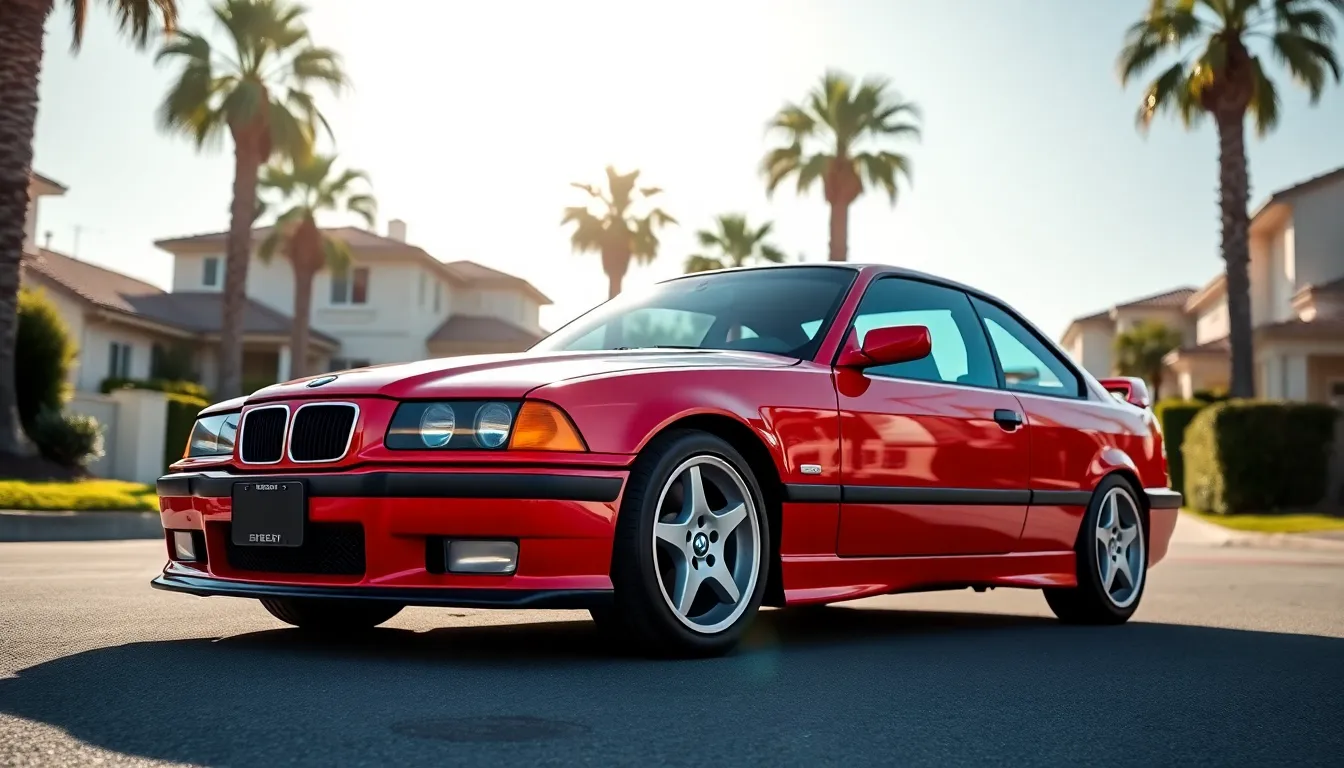
Market values for BMW E36 models have experienced important appreciation over the past five years, with certain variants commanding premium prices among collectors. M3 models represent the most valuable segment of the E36 market, with pristine examples selling between $25,000 and $45,000 depending on mileage and condition. European specification M3s with the 286-horsepower S50B30 engine typically fetch 15-20% more than their North American counterparts due to their higher performance output.
Collectibility factors heavily favor low mileage examples with comprehensive maintenance records and original paint. M3 Lightweight variants have become particularly sought after, with clean examples exceeding $60,000 at auction due to their limited production numbers and track focused engineering. Standard E36 models in coupe and convertible configurations also show strong appreciation, especially when equipped with the larger inline six engines and manual transmissions.
| E36 Model | Current Market Range | 5-Year Appreciation | Collectibility Factor |
|---|---|---|---|
| 318i/318is | $8,000-$18,000 | 35% | Moderate |
| 325i/325is | $12,000-$25,000 | 45% | High |
| 328i/328is | $15,000-$28,000 | 50% | High |
| M3 Standard | $25,000-$45,000 | 85% | Very High |
| M3 Lightweight | $50,000-$75,000 | 120% | Exceptional |
Investment potential remains strong for well maintained examples as the E36 generation represents the last purely analog BMW M3 without electronic driving aids. Enthusiast demand continues driving prices upward, particularly for unmodified vehicles with original interior components and matching numbers drivetrains. Clean title examples with under 100,000 miles command the highest premiums in today’s market.
Geographic location significantly impacts E36 values, with California and Northeast markets showing the strongest pricing due to concentrated enthusiast populations. European imports occasionally surface in the U.S. market, typically carrying premium valuations for their unique specifications and higher performance potential. Rust free examples from dry climates maintain substantial value advantages over vehicles from salt belt regions.
Modification history directly affects collectibility, with heavily modified examples experiencing value depreciation compared to stock configurations. Original BMW accessories and period correct modifications can enhance value when properly documented and professionally installed. Factory option packages like Sport Package or Premium Package add measurable value to base models across all body styles.
Future collectibility indicators suggest continued appreciation for the E36 platform as younger enthusiasts discover its driving dynamics and build quality. Limited production variants including wagon and compact models show emerging collector interest as their rarity becomes more apparent in the marketplace. Pristine examples with complete documentation represent the safest investment choices within the growing E36 collector market.
Modifications and Tuning Potential
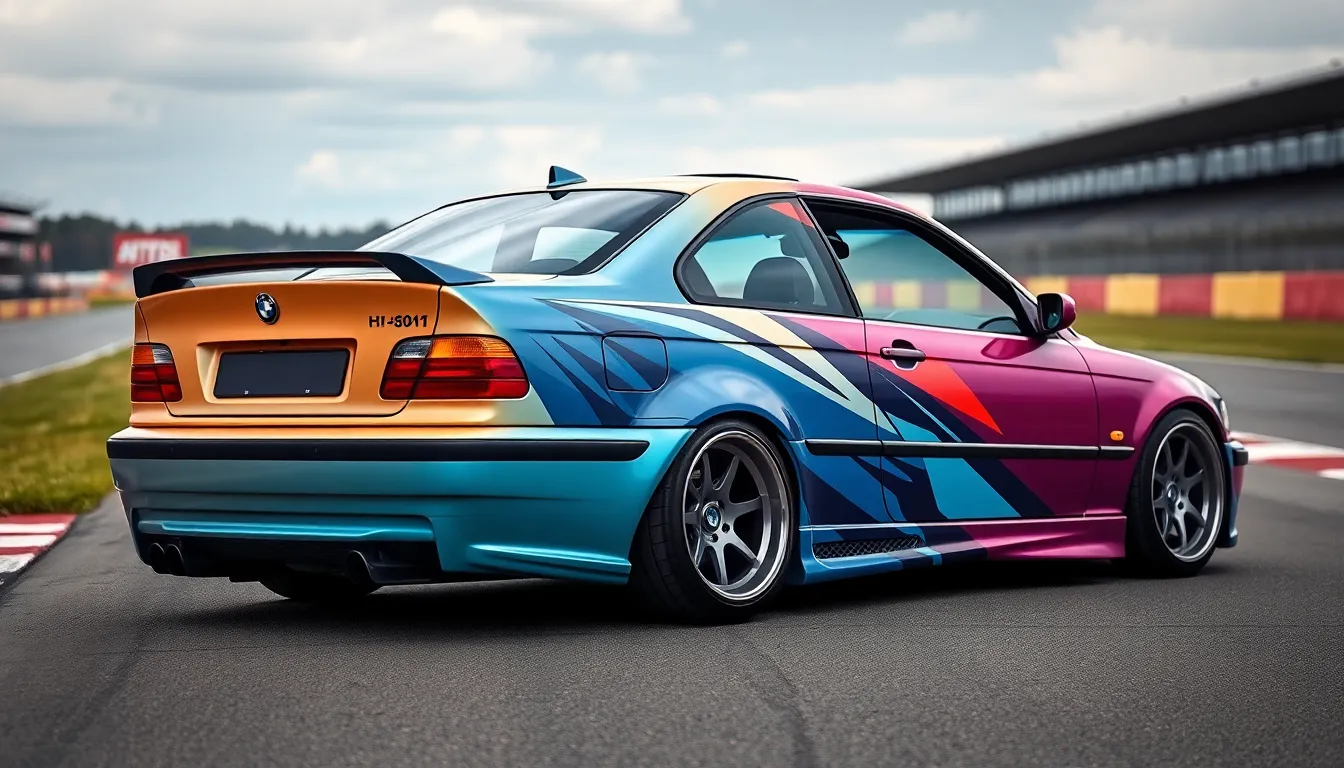
BMW E36 platforms offer extensive modification opportunities that make them highly attractive to performance enthusiasts and tuners worldwide. The robust engine architecture accepts important power increases, with naturally aspirated M52 engines commonly achieving 250-300 horsepower through bolt-on modifications like cold air intakes, exhaust systems, and performance tuning software. Forced induction conversions transform standard E36s into serious performance machines, with turbocharger kits producing 350-500 horsepower from stock internals.
Engine Performance Upgrades
Naturally aspirated builds focus on maximizing airflow and combustion efficiency through carefully selected components. Header installations increase exhaust flow by 15-20% while performance intake systems improve throttle response and add 10-15 horsepower. ECU tuning unlocks additional power by optimizing fuel maps and ignition timing, typically yielding 20-30 horsepower gains on stock engines.
Turbocharger conversions represent the most dramatic power enhancement option for E36 platforms. Single turbo setups using Garrett GT2860RS or Precision 5858 units reliably produce 400+ horsepower with supporting modifications like larger fuel injectors and upgraded fuel pumps. Internal engine modifications become necessary beyond 350 horsepower, requiring forged pistons, connecting rods, and head studs to handle increased cylinder pressures.
Suspension and Handling Modifications
Coilover suspension systems replace the factory setup to provide adjustable ride height, damping, and spring rates for improved handling characteristics. Popular options include BC Racing, KW Variant, and Bilstein PSS coilovers that allow precise suspension tuning for track or street use. Strut tower braces and chassis reinforcement bars increase structural rigidity by connecting suspension mounting points.
Performance sway bars reduce body roll during cornering while maintaining ride comfort for daily driving applications. Front strut bars measuring 25mm and rear bars at 22mm provide optimal balance between handling improvement and ride quality. Polyurethane bushings throughout the suspension system eliminate deflection and improve steering precision compared to worn rubber components.
Brake System Enhancements
Big brake kits address the increased stopping power requirements of modified E36s through larger rotors and multi-piston calipers. StopTech, Brembo, and Wilwood offer complete brake packages featuring 13-14 inch front rotors with four or six-piston calipers. Performance brake pads using compounds like Hawk HPS or EBC Redstuff provide superior stopping power and fade resistance during spirited driving.
Stainless steel brake lines eliminate expansion under pressure while performance brake fluids with higher boiling points prevent vapor lock during track sessions. Brake cooling ducts direct airflow to the rotors, reducing operating temperatures by 100-150 degrees during extended high-performance driving situations.
Aesthetic and Interior Modifications
Body modifications range from subtle aerodynamic improvements to complete visual transformations using aftermarket body kits. M3-style front and rear bumpers, side skirts, and spoilers create an aggressive appearance while improving aerodynamic efficiency. Wheel upgrades to 17-19 inch diameters with lightweight construction reduce unsprung weight by 5-10 pounds per corner.
Interior modifications focus on enhanced driver engagement through sport seats, steering wheels, and gauge clusters. Recaro and Sparco racing seats provide superior lateral support during high-g cornering while maintaining comfort for street driving. Short-throw shifters reduce throw distance by 40% for quicker gear changes during performance driving scenarios.
Modification Cost Considerations
| Modification Type | Budget Range | Expected Gains |
|---|---|---|
| Cold Air Intake + Exhaust | $800-1,500 | 15-25 HP |
| Turbo Kit (Complete) | $4,000-8,000 | 150-200 HP |
| Coilover Suspension | $1,200-3,000 | Improved Handling |
| Big Brake Kit | $2,000-4,500 | Enhanced Stopping |
| Engine Internals | $3,000-6,000 | 400+ HP Capability |
Professional installation costs add 20-40% to parts prices depending on modification complexity and local labor rates. DIY installations save important money but require proper tools and mechanical knowledge to ensure safe and effective results.
Conclusion
The BMW E36 continues to stand as one of the most compelling choices for driving enthusiasts seeking an authentic sports sedan experience. We’ve seen how this platform offers an exceptional combination of performance potential engineering excellence and long-term value appreciation.
Whether you’re considering an E36 as a daily driver project car or investment opportunity the key lies in finding well-maintained examples with complete service histories. The strong aftermarket support and active community ensure that parts availability won’t be a concern for years to come.
Today’s market presents unique opportunities for discerning buyers. Values have stabilized after recent appreciation making quality examples more accessible while still offering solid investment potential. We believe the E36’s reputation for driver engagement and modification-friendly design will keep it relevant in the enthusiast community for decades to come.
Frequently Asked Questions
What years was the BMW E36 produced?
The BMW E36 was produced from 1990 to 2000, representing the third generation of BMW’s 3 Series compact executive car lineup. During this 10-year production run, BMW manufactured over 2.4 million E36 units across various body styles including sedan, coupe, convertible, wagon, and compact variants.
What engine options were available in the BMW E36?
The E36 offered seven distinct naturally aspirated engines ranging from the base 1.6-liter M40B16 to the powerful 3.2-liter M52B32. The M3 variant featured high-performance engines including the European 3.0-liter S50B30 (286 hp) and the ultimate 3.2-liter S50B32 (321 hp), while North American M3 models had slightly detuned versions.
What are the most common problems with BMW E36 models?
Common E36 issues include cooling system failures due to deteriorating plastic components after 80,000-100,000 miles, stress cracks at rear subframe mounting points in higher mileage models, and various electrical problems. Regular maintenance including cooling system service, oil changes, and transmission servicing helps prevent these failures.
How much is a BMW E36 worth today?
E36 values have appreciated significantly over the past five years. Regular models range from $8,000-$20,000 depending on condition, while M3 variants command $25,000-$45,000. Special editions like the M3 Lightweight can exceed $60,000 at auction. Low mileage examples with comprehensive maintenance records and original paint command premium prices.
What makes the BMW E36 good for modifications?
The E36’s robust engine architecture allows for significant power increases through bolt-on modifications and forced induction conversions. Naturally aspirated M52 engines can achieve 250-300 horsepower, while turbocharger kits can produce 350-500 horsepower. The platform also supports extensive suspension, brake, and aesthetic modifications, making it highly versatile for tuning enthusiasts.
What body styles were available for the BMW E36?
The E36 was available in multiple body styles to target different market segments: four-door sedan, two-door coupe, convertible, wagon (Touring), and compact variants. Each body style maintained the core performance characteristics while offering specific advantages, with chassis tuning varying across styles to optimize performance for each configuration.
How does the BMW E36 handle compared to other cars?
The E36 set benchmarks for compact sports sedans with precise steering response and superior cornering stability. Its multi-link rear suspension and optimal 50/50 weight distribution provide excellent handling characteristics. Body rigidity improvements over the E30 enhanced both handling and safety, with the M3 variant delivering exceptional performance metrics including impressive acceleration and top speeds.
What maintenance is required for a BMW E36?
Regular E36 maintenance includes cooling system service every 60,000-80,000 miles, frequent oil changes using proper specification oil, transmission servicing, and monitoring of electrical components. Preventive maintenance is crucial as neglecting these services can lead to expensive repairs, particularly cooling system failures and subframe issues in higher mileage examples.

